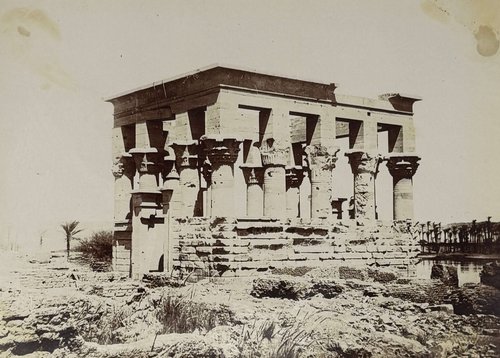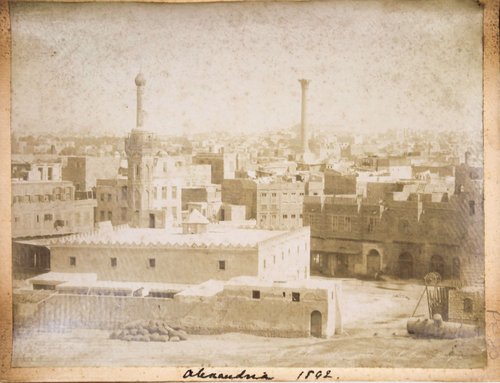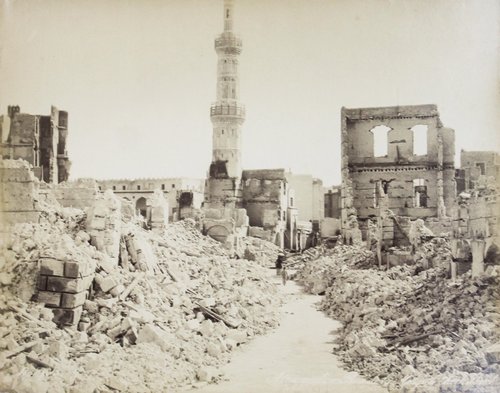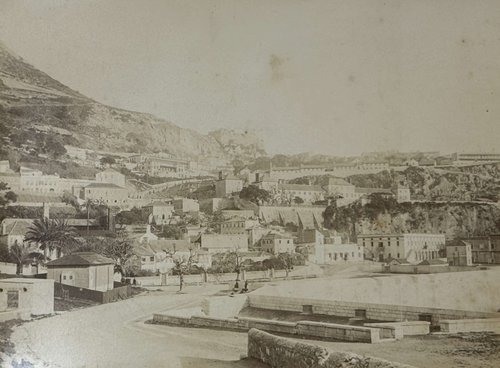





















#PA91ab
1908
Two Large Quarto albums, each ca. 30,5x24,5 cm (12 x 9 ½ in). Each with 60 card stock leaves. With 144 mounted original photos, including 122 albumen photos ca. 20x26 cm, 19 gelatin silver photos and one photochrome, all ca. 16,5x20,5 cm (6 ½ x 8 in). All photos with period ink captions in English on the mounts, ca. sixty photos with the photographers’ signatures or captions in French in negative. Two period black half moroccos with black pebbled cloth boards; front boards with gilt-lettered titles and the owner’s name; spines with raised bands, moiré endpapers; all edges gilt. Binder’s paper labels on both rear pastedown endpapers (“J. Maudsley & Son, Stationer, Castle Street, Liverpool”). Spines and corners neatly repaired, a few photos mildly faded, a couple of leaves with minor tears not affecting the images; overall very good albums of strong interesting photos.
Attractive albums housing an extensive collection of photos which document a Nile river cruise and a trip to the Holy Land, collected and taken by a prominent future Liverpool stockbroker Gray Kynoch Leathart Rae and his father, Edward Rae (1847-1923), a travel writer and himself a Liverpool stockbroker. In 1908, they went up the Nile from Cairo to the Second cataract at Wadi Halfa, visiting ancient Egyptian temples and sites on the way, and then toured around the Holy Land and Constantinople. These two albums mainly contain Antonio Beato’s classical studio photos of the Egyptian sites and antiquities collected by Gray Kynoch Rae. Out of 122 albumen photos of Egypt, about fifty-six are signed by Beato in negative, and the rest, similar in size, colour hues and style, are also attributed to him. Four photos of Hellenistic sarcophagi from Constantinople (with French captions in negative) were attributed to Pascal Sebah due to their distinctive cursive type.
Antonio Beato’s photos illustrate the Raes’ return trip down the Nile River, from the Second Cataract in Wadi Halfa to the Great Pyramids of Giza. The images show: the Second Cataract, “temple d’Ipsambul” (Abu Simbel), now non-existent Korosko village (flooded during the construction of the Aswan High Dam), Temple of Dakka, Temple of Al-Maharraqa, Temple of Kalabsha, Temple of the Beghe Island, Temple of the Philae Island (sixteen views from different angles, including a view of the Nile taken from the island), the first Cataract at Aswan, the town of Aswan and Elephantine Island, Temple of Kom Ombo, ancient quarries at Gebel el-Silsila, Temple of Edfu (eight views of various sites and bas-reliefs), Edfu village, Temple of Esna, Temple of Luxor (5), the city of Luxor (general view, Nile banks and steamers, Luxor hotel, travellers on a dahabiya, locals, &c.), Temple of Karnak (25), the village of Karnak, temples and sites of the Theban Necropolis (temples at Medinet Habu, Deir el-Bahri, Qurna, the Ramesseum, the Colossi of Memnon), Dendera Temple, general view of Asyut, bas-reliefs of the Dendera and Abydos Temples, an ancient tomb at Beni Hasan, the Pyramid of Djoser at Saqqara, the Great Pyramids of Giza, &c.
Four photos by the studio of Pascal Sébah depict three ancient Hellenistic sarcophagi excavated at the Royal Necropolis of Sidon, modern-day Lebanon (Alexander Sarcophagus, Sarcophagus of the Satrap, and Sarcophagus of the Crying Women) and the Sidamara Sarcophagus (discovered near Sidamara, modern-day central Turkey). There is also a photochrome image of the interior of the Church of Nativity in Bethlehem. Nineteen gelatin silver photos are the original vernacular photos taken during the trip. They include views of the Philae Temple, inundated after the construction of the Aswan Low Dam in 1899-1902, a Nile boat near Luxor, bas-reliefs in the Temple of Seti I in Abydos, River Jordan near biblical Bethsaida, Capernaum, Tiberias, the Sea of Galilee, portraits of young girls with water jugs in Nazareth and at “the well of Cana of Galilee,” local fishermen, &c. Several photos portray Gray Kynoch Rae, posing at the Pylon of Ramesses II of the Luxor Temple, in an orange garden near Thebes, with a camel at Wadi Halfa, “onboard Nile steamer Nefertari, Assouan,” in front of the Al-Azhar Mosque in Cairo, and “at the Edinburgh Medical Mission, Damascus.” Overall an attractive extensive collection of large, well-preserved albumen photos of Egypt, illustrating the history of the Nile river tourism in the early 20th century.
Gray Kynoch Leathart Rae “became a member of the Liverpool Stock Exchange in May 1910, and a member of the committee in April 1932. He was an active member until two weeks before his death. He was a member of the Royal Liverpool Golf Club. During the first World War, he was a captain in the Royal Artillery. In the 1939-1945 War, he joined an artillery regiment and was later an instructor with the rank of major at O.C.T.U. at Llandrindod Wells” (Liverpool Echo, 4 March 1947, p. 3).
Edward Rae was a son of a prominent banker and patron of arts (most notably, the Pre-Raphaelites) George Rae (1817-1902). He himself made a successful banking career and was a chairman of the Liverpool Stock Exchange for 21 years, authoring “the Forged Transfer Act, which has proved of inestimable value to stockholders” (Mr. Edward Rae// The Guardian. London, 28 June 1923, p. 12). In the 1870s and 1880s, he travelled across the Middle East and North Africa, as well as Lapland, Kola Peninsula and the coast of the White Sea, publishing his travel accounts with John Murray: “The Land of the North Wind, or Travels among the Laplanders and the Samoyeds” (1875), “The country of the Moors, A Journey from Tripoli in Barbary to the City of Kairwan” (1877), and “The White Sea Peninsula, A Journey in Russian Lapland and Karelia” (1881). During his travels around the Middle East, he became “one of the first Englishmen to enter the holy city of Kairwan, in Tunisia” (Mr. Edward Rae// The Guardian. London, 28 June 1923, p. 12). In 1874, Rae was elected a Fellow of the Royal Geographical Society. He was also credited with introducing the game of cricket into “Russian Lapland” (Weird… but True: Curious Cricketing Tales, 1892-2006// The Independent. London, 23 August 2006, p. 56).





























